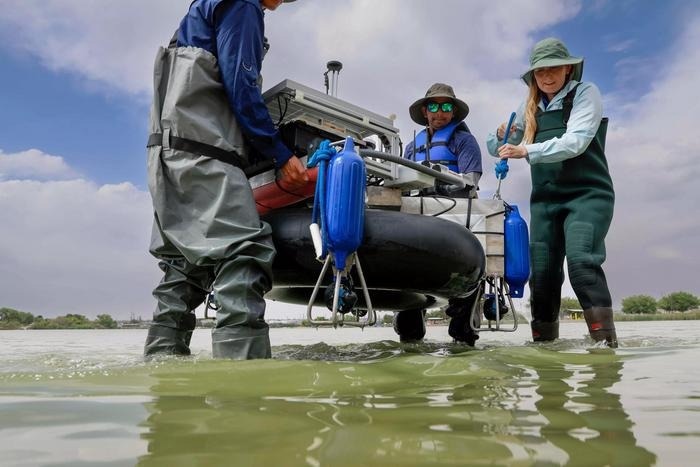Scientists at The University of Texas at El Paso have built a completely autonomous boat that can perform bathymetric surveys of the terrain and depth of waterbodies such as rivers, oceans, and lakes.

From left to right: UTEP alumnus Fernando Sotelo, doctoral student Jayanga Thanuka Samarasinghe and Assistant Professor Laura Alvarez, Ph.D., carry a boat from shore into Ascarate Lake, located in El Paso, Texas. The fully autonomous boat can carry out bathymetric surveys — surveys of the depth and terrain of bodies of water like oceans, rivers and lakes. Image Credit: The University of Texas at El Paso
The team believes that the robotic boat can aid in streamlining the survey process, which typically takes a team of individuals to finish, alongside assisting reconnaissance missions.
The May issue of the journal Sensors discusses the boat and its abilities.
There are lots of reasons scientists carry out bathymetric surveys. If you want to work in water-related studies, you need to know the shape and landscape of bodies of water. For example, you might want to map a reservoir to learn about water supply for electrical demand, or a river to learn about river evolution or flow patterns.
Laura Alvarez, PhD, Study Lead Author, The University of Texas at El Paso
Alvarez, an Assistant Professor in the Department of Earth, Environmental and Resource Sciences of UTEP, is an expert in unmanned systems for earth science. She began developing the boat many years ago but wanted support in tweaking and perfecting the system.
That is when she recruited Fernando Sotelo ’22, a master’s electrical engineering student from the Department of Electrical and Computer Engineering.
“The first time we tested the boat was at the swimming pool at UTEP—just to make sure it could float,” laughed Fernando Sotelo, a study co-author and now UTEP alumnus.
In one year, Sotelo fine-tuned the aluminum watercraft, a 3-foot × 3-foot circular craft that is located on a thick black inner tube, assessing it in different environments such as New Mexico’s Grindstone and Elephant Butte lakes.
His objectives comprised extending the boat’s hours of functioning and dependability and making it completely independent and reactive to possible environmental problems, such as temperature flux and wind speed. A failsafe can sometimes sense when wind gusts are too high, or batteries are low and trigger a return-to-base function.
The rudderless watercraft functions with four thrusters, enabling it to move up to 5 feet every second and seamlessly rotate 360°. A lithium battery and solar panel enable the boat to last a maximum of four hours at sea—covering a maximum region of 472,400 square feet.
Throughout the duration, a sonar system, a multibeam echosounder, emits sound waves from the bottom of the boat. The time taken for the sound wave to hit the seafloor and return to the sonar system is used to calculate the water depth. The sound returning to the device can sense the kind of material on the seafloor.
To exhibit proof-of-concept, the research group efficiently made 2D and 3D maps of portions of Ascarate Lake in El Paso, Texas and Grindstone Lake in Ruidoso, New Mexico.
My goal was to make the boat state-of-the-art and I think I did that. Of course, there’s always room to improve. But the system works and for now, I hope it can make it easier for scientists like Dr Alvarez to conduct their research.
Fernando Sotelo, Student, Electrical Engineering, Department of Electrical and Computer Engineering, The University of Texas at El Paso
Sotelo also worked on the boat for his master’s thesis.
To study the Rio Grande River’s depth and flow, Alvarez will employ the boat for the first time this summer.
She also states that the instructions to replicate the boat are published online in their recent Sensors publication.
“The reason we wrote the paper was so that anyone can reproduce it by themselves. It serves as an effective guideline to get them started,” Alvarez added.
The study was partly financed by The National Oceanic and Atmospheric Administration (NOAA) Educational Partnership Program/Minority-Serving Institutions (CESSRST-II) and The National Science Foundation (NSF).
This Self-driving Boat Maps Underwater Terrain
Researchers at The University of Texas at El Paso have constructed a fully autonomous boat that can carry out bathymetric surveys — surveys of the depth and terrain of bodies of water like oceans, rivers, and lakes. The team hopes the robotic boat can help simplify the survey process, which usually takes a crew of individuals to complete, as well as assist with reconnaissance missions. Video Credit: UTEP Communications
Journal Reference:
Sotelo-Torres, F., et al. (2023) An Unmanned Surface Vehicle (USV): Development of an Autonomous Boat with a Sensor Integration System for Bathymetric Surveys. Sensors. doi.org/10.3390/s23094420.